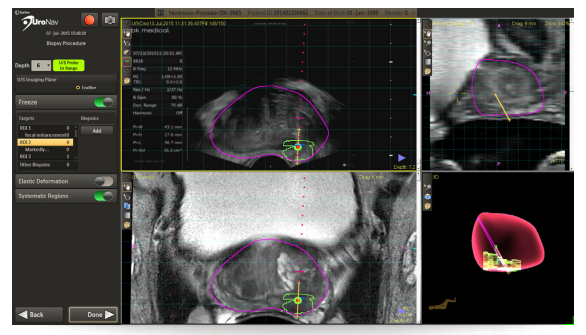Current imaging system resolution can cause needles to miss tumors during a pancreatic cancer biopsy procedure. However, a new imaging system developed by Invivo promises to create an improved image for guiding the biopsy needle to the tumor.

MR/US fusion aligns and registers prior diagnostic MR images (bottom) with real-time ultrasound images (top). The purple outline displays the segmented prostate anatomy from the MR exam and green/red “targets” indicate the location of the MR suspicious lesions. (Credit: UroNav)
According to Invivo, the new Uro Nav Fusion Biopsy System features a two-part system that combines the pre-biopsy MR images of the prostate with real-time, ultrasound-guided biopsy images. At the same time, the system “combines electromagnetic tracing and navigation (like a GPS) with an onboard computer and a real-time imaging interface.”
An electromagnetic navigation sensor attaches to an ultrasound transducer and is positioned over the patient. The navigation system tracks the biopsy needle, matching the traditional biopsy procedure.
Using this technology, doctors can directly pinpoint tumors and get tissue samples without needing pre-biopsy MR data.
“This […] saved me a lot of pain by finding the cancer very specifically without having to shoot all over my prostate in order to find it,” says former patient Allen Morris. “If I wouldn’t have had this now, I think it would have killed me eventually.”
The Uro Nav Fusion Biopsy System will be launching in early 2017.
